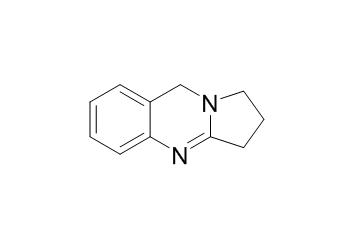Desoxypeganine
Desoxypeganine is a cholinesterase inhibitor, acting preferentially on butyrylcholinesterase, and as a selective inhibitor of monoamine oxidase A but not monoamine oxidase B.Desoxypeganine is being developed for its potential utility in the pharmacological treatment of alcohol abuse to reduce craving and depression in alcohol abusers, and might also be useful as a smoking cessation aid.
Inquire / Order:
manager@chemfaces.com
Technical Inquiries:
service@chemfaces.com
Tel:
+86-27-84237783
Fax:
+86-27-84254680
Address:
1 Building, No. 83, CheCheng Rd., Wuhan Economic and Technological Development Zone, Wuhan, Hubei 430056, PRC
Providing storage is as stated on the product vial and the vial is kept tightly sealed, the product can be stored for up to
24 months(2-8C).
Wherever possible, you should prepare and use solutions on the same day. However, if you need to make up stock solutions in advance, we recommend that you store the solution as aliquots in tightly sealed vials at -20C. Generally, these will be useable for up to two weeks. Before use, and prior to opening the vial we recommend that you allow your product to equilibrate to room temperature for at least 1 hour.
Need more advice on solubility, usage and handling? Please email to: service@chemfaces.com
The packaging of the product may have turned upside down during transportation, resulting in the natural compounds adhering to the neck or cap of the vial. take the vial out of its packaging and gently shake to let the compounds fall to the bottom of the vial. for liquid products, centrifuge at 200-500 RPM to gather the liquid at the bottom of the vial. try to avoid loss or contamination during handling.
ACS Synth Biol.2022, 11(10):3296-3304.
Indian Journal of Science and Technology2023, 16(SP1):48-56.
J Liq Chromatogr R T2025, 2505536.
BMC Pharmacol Toxicol.2018, 19(1):5
Separations2023, 10(2), 131.
Antioxidants (Basel).2020, 9(4):284.
Processes2020, 8(12),1540.
Appl. Sci.2023, 13(17):9984.
Food Chem.2019, 276:768-775
Res Pharm Sci.2023, 18(3):244-261.
Related and Featured Products
Int J Clin Pharmacol Ther. 2009 Jul;47(7):483-90.
Randomized, crossover, single-blind, placebo-controlled, human pharmacology clinical trial with desoxypeganine, a new cholinesterase and selective MAO-A inhibitor: multiple-dose pharmacokinetics.[Pubmed:
19640356]
Desoxypeganine, a naturally occurring alkaloid, is being developed for its potential utility in the pharmacological treatment of alcohol abuse to reduce craving and depression in alcohol abusers, and might also be useful as a smoking cessation aid. During the preclinical development it was characterized as a cholinesterase inhibitor, acting preferentially on butyrylcholinesterase, and as a selective inhibitor of monoamine oxidase A but not monoamine oxidase B. The aim of the present human pharmacology clinical trial was to assess the oral bioavailability, pharmacokinetic profile and tolerability of Desoxypeganine, administered in a multiple-dose regimen to healthy volunteers.
METHODS AND RESULTS:
Eighteen healthy adult volunteers of both sexes received placebo, 50 mg and 100 mg Desoxypeganine (b.i.d. for 3 days) in a single-blind, crossover, randomized manner. Main pharmacokinetic parameters after single and multiple doses were estimated. Clinical tolerability and clinical laboratory safety, including effect on QTc interval, were assessed. Non-compartmental estimations of Cmax, AUC, tmax, t1/2 and MRT at 12-h intervals are given. No significant dose effect was observed in tmax, t1/2 and MRT. Cmax and AUC are approximately double with the dose of 100 mg comparing with the dose of 50 mg. A significant increase (p < 0.05) on Cmax and AUC was also obtained with the highest dose administered in comparison with the lowest one, revealing a slight but clinically insignificant accumulation. Steady state of drug concentration was reached in both genders during the study period. Plasma protein binding of Desoxypeganine amounted to approximately 18%. No severe adverse events were recorded and none of the subjects suffered from any adverse event that led to withdrawal from the study. Most frequently recorded adverse event was dizziness. No significant effects of Desoxypeganine on vital signs, laboratory parameters or QTc interval were observed.
CONCLUSIONS:
The present clinical trial describes the pharmacokinetic profile of two doses of Desoxypeganine, administered orally in multiple dose to healthy volunteers. The drug was well tolerated without any severe clinical, clinical laboratory, or ECG adverse events being recorded.
Methods Find Exp Clin Pharmacol. 2008 Mar;30(2):141-7.
Phase I clinical trial with desoxypeganine, a new cholinesterase and selective MAO-A inhibitor: tolerance and pharmacokinetics study of escalating single oral doses.[Pubmed:
18560630 ]
Desoxypeganine (DOP) is a natural alkaloid that has been characterized as a cholinesterase inhibitor and a selective inhibitor of monoamine oxidase A. DOP has been investigated for its potential utility in the pharmacological treatment of alcohol abuse and as a smoking cessation aid. The aim of this clinical trial was to evaluate the tolerance and single-dose pharmacokinetic profile of DOP in healthy human volunteers.
METHODS AND RESULTS:
The study was an open-label, dose-escalation, phase I clinical trial involving the administration of increasing single oral doses of DOP (50, 100, 150 and 200 mg). The study was conducted according to the Declaration of Helsinki and Good Clinical Practice. Eighteen healthy adult volunteers (8 males and 10 females, age ranging 20-30 years) were recruited. DOP was administered sequentially, escalating in single doses of 50, 100, 150 and 200 mg in four experimental sessions with a washout period of at least 1 week between them. Progress to the next dose was allowed only if the previous dose was tolerated. Pharmacokinetic parameters were determined using noncompartmental methods. Clinical and analytical safety was assessed throughout the study, and QTc intervals were measured at regular intervals. The main pharmacokinetic parameters and renal excretion are described. No serious adverse events were registered, and none of the subjects discontinued the study because of lack of tolerance. All the adverse events recorded were mild to moderate and increased with the dose. The ECG measurements revealed that even at a higher dose, the QTc interval remained below the safety threshold.
CONCLUSIONS:
In summary, this first phase I study indicates that DOP has linear and dose-proportional pharmacokinetics, satisfactory oral bioavailability and plasma half-life and renal excretion. Also, DOP has shown an adequate safety profile that allows the continuation of clinical development.



